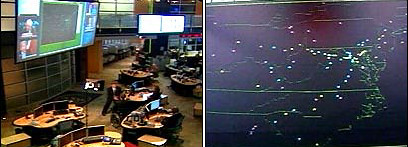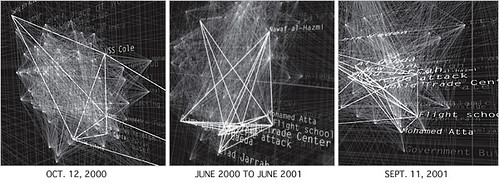Architectural Clairvoyance and the Spaces of Terrorist Prevention
In a vaguely revealing article the BBC managed to visit “one of America's newest and most secret establishments”: the National Counterterrorism Center, or, the NCTC - described as the “beating heart of America's counter-terrorism nerve centre.”

[Image: Inside the US counter-terror nerve centre, BBC - 2006.]
Behind the walls of a non-descript building somewhere in a quiet Washington suburb, multiple watch-teams sift their way through an endless barrage of data viz and intelligence. For 12 to 24-hours-a-day, seven-days-a-week, they analyze over “6,000 reports [that] come through every day from satellite, electronic and human intelligence sources,” in an attempt to trace nothing less than the unfathomable patterns of a fortuitous geometry of hidden connections, that could somehow help predict the next terrorist attack.

[Image: As reported in this New York Times article on Open-Source Spying, These images represent terrorist attacks and some of the actors, weapons and targets linked to them. The physical relationship of the items suggests the level of connection. Illustrations by Lisa Strausfeld and James Nick Sears/Pentagram. Read this explanation.]
As if every attack were a sort of cryptic architecture forshadowed in scattered bits of incriminating data that merely waited to be extracted and linked together into unexpected form - I wonder, what architectural taxonomy we could decipher of past terrorist attacks by going back and re-analyzing all of the old data, and by connecting the dots of what we know now with what we knew only then. From that, could we create a sort of history of terrorism told in architectural form?
What if we found that all of the “early signs” surrounding each and every car bomb incident ironically took on a similar model, or data set - a like-patterned constellation of pre-intelligence? What if suicide attacks as a genre of terrorism revealed a kind of intelligence architecture that was consistent with all other suicide attacks around the world? Would surveillance and counter-terrorism experts become insane decoders of mysterious and elusive shape in data analysis? What if the task of “intelligence crunching” and “terrorism prediction” became a sort of informal practice of forensic architectural design? Would architects gain new stature as the clairvoyant heroes of terrorism prevention? Would the NCTC essentially become the most important architecture firm on the planet?
(yeah, whatever...thanks, Geoff for the news link!)

[Image: Inside the US counter-terror nerve centre, BBC - 2006.]
Behind the walls of a non-descript building somewhere in a quiet Washington suburb, multiple watch-teams sift their way through an endless barrage of data viz and intelligence. For 12 to 24-hours-a-day, seven-days-a-week, they analyze over “6,000 reports [that] come through every day from satellite, electronic and human intelligence sources,” in an attempt to trace nothing less than the unfathomable patterns of a fortuitous geometry of hidden connections, that could somehow help predict the next terrorist attack.

[Image: As reported in this New York Times article on Open-Source Spying, These images represent terrorist attacks and some of the actors, weapons and targets linked to them. The physical relationship of the items suggests the level of connection. Illustrations by Lisa Strausfeld and James Nick Sears/Pentagram. Read this explanation.]
As if every attack were a sort of cryptic architecture forshadowed in scattered bits of incriminating data that merely waited to be extracted and linked together into unexpected form - I wonder, what architectural taxonomy we could decipher of past terrorist attacks by going back and re-analyzing all of the old data, and by connecting the dots of what we know now with what we knew only then. From that, could we create a sort of history of terrorism told in architectural form?
What if we found that all of the “early signs” surrounding each and every car bomb incident ironically took on a similar model, or data set - a like-patterned constellation of pre-intelligence? What if suicide attacks as a genre of terrorism revealed a kind of intelligence architecture that was consistent with all other suicide attacks around the world? Would surveillance and counter-terrorism experts become insane decoders of mysterious and elusive shape in data analysis? What if the task of “intelligence crunching” and “terrorism prediction” became a sort of informal practice of forensic architectural design? Would architects gain new stature as the clairvoyant heroes of terrorism prevention? Would the NCTC essentially become the most important architecture firm on the planet?
(yeah, whatever...thanks, Geoff for the news link!)







7 Comments:
Interesting stuff, a good read.
Check out my blog for a unique viewpoint on the US' role in the world today.
http://usterrorism.blogspot.com/
If you link to mine I will link to yours.
thanks. i will check your blog out when i get a chance.
Well, safe is now to say, my nifty lil spatial data prevention architecture theory has been pretty much dismantled.
Data Diver Disses Terror-Mining
"Terrorism has no similar indicia. With a relatively small number of attempts every year and only one or two major terrorist incidents every few years—each one distinct in terms of planning and execution—there are no meaningful patterns that show what behavior indicates planning or preparation for terrorism. Unlike consumers’ shopping habits and financial fraud, terrorism does not occur with enough frequency to enable the creation of valid predictive models. Predictive data mining for the purpose of turning up terrorist planning using all available demographic and transactional data points will produce no better results than the highly sophisticated commercial data mining done today [with results in the low single-digits – ed.]. The one thing predictable about predictive data mining for terrorism is that it would be consistently wrong."
(from Jeff Jonas, "one of the country's leading practitioners of the dark art of data analysis.")
Your considerations are simultaneously amazing and shocking. Amazing because show off human skills to predict events - as many cientists have said we could; but it is shocking thinking what is going to happen with public space: would became they a sort of space without any quality but only setting free inside who is consuming? It is a nightmare, but I do not think this pattern has spread all over the world. Best regards.
rcesar
thanks for your comment. this quote from a recent interview with simon norfolk, as reported here, seems timely:
“All of the work that I’ve been doing over the last five years is about warfare and the way war makes the world we live in. War shapes and designs our society. The landscapes that I look at are created by warfare and conflict.
I'm trying to stretch that idea of what a battlefield is. Because all the interesting money now – the new money, the exciting stuff – is about entirely new realms of warfare: inside cyberspace, inside parts of the electromagnetic spectrum: eavesdropping, intelligence, satellite warfare, imaging. This is where all the exciting stuff is going to happen in twenty years' time. So I wanted to stretch that idea of what a battleground could be. What is a landscape – a surface, an environment, a space – created by warfare?”
Now that really made me wonder, is the Government really spying in all of us? I mean listening to phone calls and reading private emails and stuff like that? Well, they have a lot of secrets and I don't think that we can really know the answer to most of them.The good part is that they are doing a lot of stuffs to protect us all.
The government only protects their own governance.
Post a Comment
<< Home